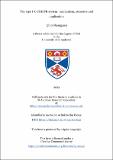Files in this item
The type I-G CRISPR system : mechanism, structure and application
Item metadata
| dc.contributor.advisor | White, Malcolm F. | |
| dc.contributor.author | Shangguan, Qilin | |
| dc.coverage.spatial | 218 | en_US |
| dc.date.accessioned | 2023-11-01T14:50:52Z | |
| dc.date.available | 2023-11-01T14:50:52Z | |
| dc.date.issued | 2023-11-28 | |
| dc.identifier.uri | https://hdl.handle.net/10023/28610 | |
| dc.description.abstract | CRISPR is originally discovered as an adaptive immune system in prokaryotes. It has been widely repurposed for application in different microbiological fields attributed to its ability to target DNA or RNA in a sequence-specific manner. But there is always an uncharted area of CRISPR systems in nature, awaiting exploration. The type I-G CRISPR system is one of the subtypes of type I CRISPR systems with a multi-subunit effector complex compared to type II CRISPR-Cas9, a single subunit effector. Characterised by the enigmatic cas proteins Csb2 and Cas8g, type I-G system is the least understood type I system and possesses a unique mechanism in CRISPR recognition and interference. In this thesis, we expressed and reconstructed a type I-G system from Thioalkalivibrio sulfidiphilus. We present key insights into the biochemistry and mechanism of the system, and a first view of the structure of the effector complex of type I-G is provided. Heterologous expression of type I-G in Escherichia coli provides immunity against mobile genetic elements. Repurposing type I-G for genome editing in E. coli with atypical Cas3 generates desirable editing. These observations provide an overview of the type I-G system, potentiating fundamental studies and further applications. | en_US |
| dc.language.iso | en | en_US |
| dc.relation | The type I-G CRISPR system: mechanism, structure and application (thesis data) Shangguan, Q., University of St Andrews, 20 Oct 2023. DOI: https://doi.org/10.17630/d54ca921-ef39-44bc-8522-4696f2234947 | en |
| dc.relation.uri | https://doi.org/10.17630/d54ca921-ef39-44bc-8522-4696f2234947 | |
| dc.rights | Creative Commons Attribution-ShareAlike 4.0 International | * |
| dc.rights.uri | http://creativecommons.org/licenses/by-sa/4.0/ | * |
| dc.subject | CRISPR | en_US |
| dc.subject | Type I-G | en_US |
| dc.subject | Genome editing | en_US |
| dc.subject.lcc | QH442.S5 | |
| dc.subject.lcsh | CRISPR (Genetics) | en |
| dc.subject.lcsh | Gene editing | en |
| dc.subject.lcsh | Microbial genetics | en |
| dc.title | The type I-G CRISPR system : mechanism, structure and application | en_US |
| dc.type | Thesis | en_US |
| dc.contributor.sponsor | Biotechnology and Biological Sciences Research Council (BBSRC) | en_US |
| dc.contributor.sponsor | Medical Research Council (MRC) | en_US |
| dc.contributor.sponsor | China Scholarship Council (CSC) | en_US |
| dc.type.qualificationlevel | Doctoral | en_US |
| dc.type.qualificationname | PhD Doctor of Philosophy | en_US |
| dc.publisher.institution | The University of St Andrews | en_US |
| dc.publisher.department | Biomedical Sciences Research Complex | en_US |
| dc.identifier.doi | https://doi.org/10.17630/sta/645 | |
| dc.identifier.grantnumber | REF: BB/S000313/1 to MFW | en_US |
| dc.identifier.grantnumber | REF: MR/S021647/1 to RS | en_US |
| dc.identifier.grantnumber | REF: 202008060345 to QS | en_US |
The following licence files are associated with this item:
This item appears in the following Collection(s)
Except where otherwise noted within the work, this item's licence for re-use is described as Creative Commons Attribution-ShareAlike 4.0 International
Items in the St Andrews Research Repository are protected by copyright, with all rights reserved, unless otherwise indicated.


